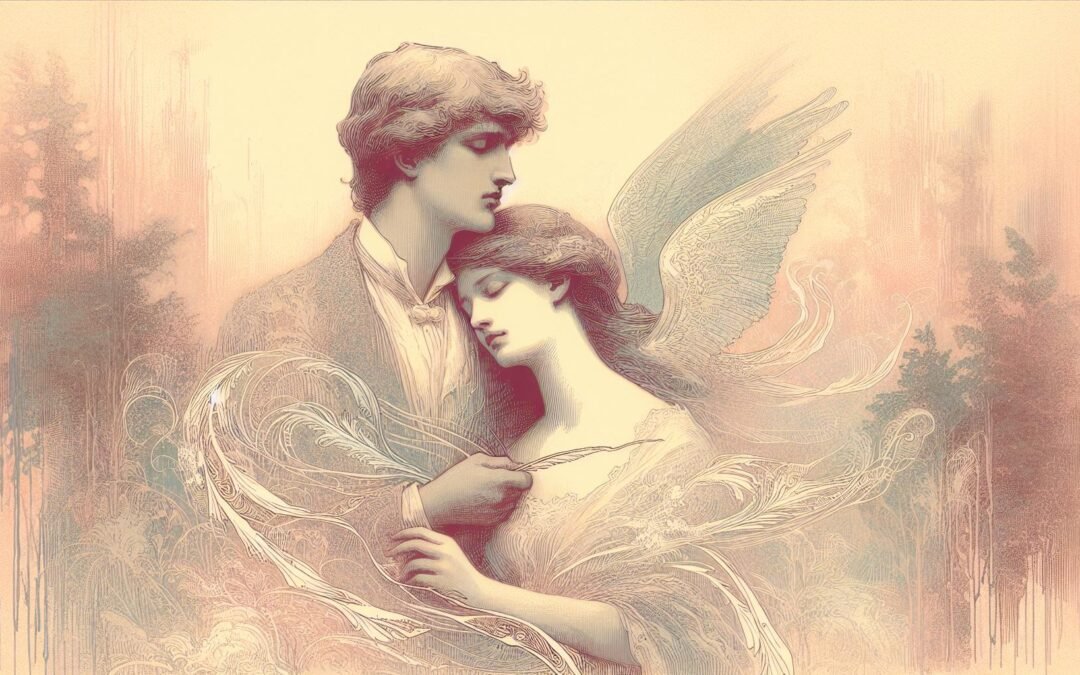A love poem for wife resists formula. Rooted in marriage’s daily reality, it draws from lineage, individuality, and an instinct for surprise. Composing a love poem for my wife invites invention through detail, memory, and the ritual of shared existence. The landscape spans centuries of poetic architecture, from ancient rites to restless modernity. Any tradition that ignores specificity risks becoming ornamental, while sincerity requires a voice with salt and patience.
Historical Shifts in the Love Poem for My Wife
Civilizations cultivate love poetry through unique languages and customs. In Sumer, temple hymns for Inanna and Dumuzi intertwine sensual longing with the symbolism of harvest. Ancient Egypt’s “charming brother” poems celebrate desire in everyday gestures, with references to perfume, gardens, and fields that echo the rhythm of river life. Sanskrit Gāthā saptaśatī, composed in India, locates yearning within the cyclical return of monsoons and blooming mango trees. The muwashshah of Andalusia turns absence into lyric refrain, echoing beneath olive groves. Persian poets including Hafez use marital imagery to suggest union between souls and cosmic harmony. Each epoch produces distinct metaphors and objects of affection, reflecting the society’s own ideals about marriage.
Transformation of Poetic Forms
The Greek lyric, shaped by Sappho’s fragments and epithalamia, holds marital intimacy near the realm of the sacred. Sappho offers glimpses of ceremonies and touch, while epithalamic verses bless the union through divine favor. Classical Chinese shi and ci poetry treats the patience of partnership with restraint. For example, in Song dynasty verse, the echo of footsteps along quiet corridors evokes separation and reunion without direct disclosure. In Occitan, troubadour poetry codifies devotion amid distance, shifting over time to address wives with private language hidden within public ritual. The Renaissance multiplies forms and tones. Shakespeare’s sonnets use rigid meter to question fidelity and attraction, then pivot toward candor and partnership. In Japan, waka and renga link poetic voices into communal affection, while Sei Shōnagon’s Pillow Book references short poems that record fleeting moments between spouses.
Spousal Devotion among Major Poets
Elizabeth Barrett Browning’s “Sonnets from the Portuguese” remap the marriage poem, blending protest against societal boundaries, reverence for the beloved’s intellect, and a vulnerability marked by the shadow of loss. Rainer Maria Rilke’s correspondence and poems recast his partner as both muse and interlocutor, fusing biography with mythology. Pablo Neruda’s “Cien sonetos de amor” invests simple substances like bread and clay with conjugal symbolism, framing his wife as both earth and sustenance. These poets expand tradition by grafting their private rituals onto a public inheritance, treating the poem as material shaped by countless hands. Influences ripple outward; new works respond to the old while seeking an unmistakable, singular tone.
Key Motifs and Emotional Architecture
Themes of loyalty and gratitude thread through poems about marriage. Expressions of fidelity may gesture toward everyday routines rather than grand promises, revealing care in small acts—a gesture set in the memory of a kitchen, a glance across a crowded room. Admiration carries weight when the beloved’s aging or change becomes a site for rediscovered beauty. Classics focus on partnership as evolving rather than settled; negotiation and interdependence appear not as stasis, but as the choreography of waking life. Gratitude gains force when language remains humble, naming both ordinary and rare moments that a spouse brings into being.
Thematic and Linguistic Complexity
Poems fixate on the ordinary: the warmth in sharing a slice of bread, the texture of shirts folded together, the fleeting amusement of an inside joke. Transforming routine into ritual, the best love poems for my wife make quiet gestures luminous instead of chasing fireworks. When tradition highlights passionate speech, modern voices falter beautifully in the shadow of lived experience—a look, a murmur, the influence of footsteps synchronizing across familiar floors.
Memory, Joint Experience, and Aspirational Vision
Personal memory saturates spousal poetry, giving present experience the flavor of layered history. The poet remembers first meetings, traces of a conversation at dusk, or anniversaries written into the lines of a hand. Shared journeys become maps of resilience, humor, and adaptation, while hope stretches into the future. The craft lies in encoding decades of anticipation, the wish for gentleness over time, and unspoken dreams maintained by shared faith.
Choosing Language: Concrete and Abstract
Diction sharpens or blurs the emotional weight of a poem. The chipped mug by the sink, threads of hair upon a pillow, sunlight across kitchen tiles—all anchor the love poem in sensory reality. Words like devotion or destiny may lend grandeur but can dissolve into vagueness if overused. Powerful lines create a circuit between tangibility and emotion, for example: “your laughter is honey unlocked each morning.” In that phrase, a symbol is given physical shape and fresh meaning.
Imagery and Figurative Construction
Sensory imagery grows essential. A poem pulses with the cool relief of linen, the salt of shared tears, or the low drone of an evening song. Metaphor remaps ordinary presence as landscape, revealing one’s wife as a shoreline shaped by return and memory. Simile introduces gentle comparisons: “your patience gentle as willow shade.” Synesthesia—tasting color or hearing scent—bestows the poem with shimmering depth: “she sings in claret velvet,” where a color pulses audibly.
Originality Versus Cliché
Rhythms and hearts, although familiar, lose impact through endless repetition. Lexical precision revives meaning by citing, for instance, a street significant to the couple, or recalling the texture of shared hardships. Authority grows from precision. Innovation emerges in startling juxtapositions and apparent contradictions, as when a wife’s patience appears in “the hush suspended between tides.” Such language avoids predictability. A poet should seek new registers by risking strangeness and selecting uncommon vocabularies, an ethos visible in the evolution of contemporary spousal poetry.
Culture, Multilingual Endearments, and Intimacy
Threads of cultural heritage enrich the private world of the poem. Words like “habibti,” “querida,” or “koibito” bear nuances impossible to replicate in English and summon family, migration, and the act of code-switching to the poem’s surface. Including specific phrases or pet names can call up the scent of home and carry a living, ancestral current into the marriage’s intimacy. The most evocative love poems for my wife demonstrate how language made elsewhere can shape the soil of shared identity and authenticity, for more on these nuances visit this anthology.
Structural Choices and Poetic Form
Form determines energy. Sonnets work through internal turn and argument, ideal for complex affection. Free verse, with loose rearrangements, matches the improvisation of daily routines. Haiku condenses emotional intensity into a brief flash, while ghazals circle the themes of separation and longing through repetition. Forms enforce discipline but also unleash creativity; a stanza-by-stanza recounting of marital years or notable journeys brings chronology into the poem’s skeleton. Acrostics and abecedarians give voice to personal rituals, spelling names or intimate alphabets.
Meter, Rhyme, and Line Breaks
Meter provides continuity and rhythm, as in iambic pentameter where steady sound mimics enduring affection. Rhyme, whether perfect or slant, echoes lovers’ shared language and history through repeated sounds. Line breaks modulate breathing and timing. An enjambed line introduces suspense and prolongs emotion, mirroring the continuing, unclosed conversation present in marriage. Structure individualizes the poem as much as content, demonstrated in modular works where each stanza memorializes a separate chapter or facet.
Influence of Notable Poets on Form
Poets like Anne Carson combine classical and novel elements, constructing forms tailored to their own marriage narratives. Their experiments invite writers to test genre boundaries and see the form as both vessel and tribute. Turning to contemporary models and classic sources, more discussion can be found on innovation in spousal poetry.
Intimacy, Symbolism, and Authenticity
Personal history transforms generalities into lived experience. The outline of a first apartment or mention of a spouse’s quirks—perhaps collecting outdated travel mugs or humming particular lullabies—renders the poem unmistakable. Symbols coined in courtship or objects imbued with private resonance take on mythic scale within marriage’s shared vocabulary. This process roots affection in the unrepeatable strangeness of two lives joined for decades.
Balancing Private Truths and Universal Reach
A strong poem reaches both its subject and an implied audience. Shared motifs invite readers into familiar architectures, while localizing images carve out what belongs only to the marriage described. Interplay between these energies fosters empathy as well as appreciation for limits. Exclusive details sharpen the sense of genuine connection and allow others to glimpse but never wholly claim the private world depicted. Discussion of similar dynamics appears at sweet poetry collections.
Vulnerability and Ethics in Marital Poetry
Naming discord or moments of regret within the poem signals both courage and mutual respect. Candid lines insist on transparency, yet discretion prevails when necessary to protect the dignity of the relationship. This friction between revelation and restraint heightens authenticity. Marital poems, in their most compelling form, risk emotional exposure while acknowledging the spouse’s role as partner, reader, and co-author. Modern examples navigate these questions within evolving notions of autonomy, devotion, and shared art, explored further on the major poetry book lists.
A love poem for my wife continues building new structures with old stones, honoring both tradition and personal voice.

